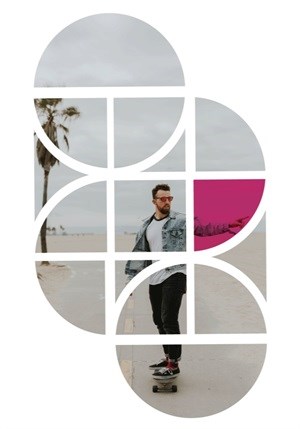
Tim Allemann
Having recently gone through a brand redesign, and having prepared extensively for the process, we’ve learnt a few good lessons. Here’s the process we followed to create a new identity that we believe truly reflects our values:
1. Define your company strategy
Your new identity has to be based on where you are going, so you and your designer or agency need to have clarity on this. You need to look not only at your business strategy, but also at what your competitors are doing in the market. Be as forward thinking as you can be, because every company is evolving, so there’s no point in creating an identity that’s only perfectly relevant to where you are right now.
2. Evaluate your existing distinctive brand assets
Brand assets are not only your logos, your font or your existing colour palette, but extend into multiple elements that make you recognisable, even the themes that you use in your advertising or office spaces. For example, remember the Savanna cider TV campaign that employed brand assets that went beyond the logo of the tree in the veld? Savanna was so tightly associated with the dimly-lit pub scene, the dry humour, and even Barry Hilton, that these assets became intrinsically associated with the brand - especially the dry humour. You could have all those elements together without using the Savanna logo, and the public would still know what was being advertised. So, when you are doing your corporate identity audit, don’t stop at the classic visual elements, but expand into all the brand assets that are associated with your business.
3. Carry out market and competitor research
You do not operate in a vacuum, so you need to understand more than your brand’s values and identity. You also need to understand competitors’. Look at what everyone else is doing so that you can identify what is uniquely yours. This is true from both a business and from a corporate identity perspective.
4. Determine what to keep and what to let go of
Once you know what is distinctly yours and what differentiates you, think about what you should keep and what you are willing to (or want to) let go. For instance, a brand asset that you like, but that is actually similar to that of a number of your competitors may not be worth hanging on to. Or something that has worked for you in the past, but is now associated with something your business is moving away from should also go. But if you have a colour that people identify you with, or a beloved aspect of your logo, then try to find a way of carrying that forward. Remember that you not only want to be recognised for what you do, but also for being unique in your category, so make your selections with that in mind.
5. Partner with a good agency with trusted talent
Use a professional agency or individual to help you develop your brand identity. While you may know your brand like the back of your hand, an experienced professional will know how to translate your brand values into something simple, visual and current. They will also know how to best support you through the process of articulating your requirements so that the ultimate end-product is a representative expression of these.
6. Accept that it’s a process
Don’t be alarmed if the first iteration of the process is nothing like what you had in mind and doesn’t feel right to you. It takes time and reworking to get your identity to where it should be. Don’t be shackled by outdated thinking; listen to what your agency has to say, but remember that you are the brand custodian and in the end, the identity has to fit the brand. But trust that the process will get you there.
7. It doesn’t stop at the logo
Brand identity is about so much more than just a logo. Think carefully about the colours you use, the fonts, the spacing, iconography, how you treat imagery, and the many additional brand assets you might end up using. With so many platforms on which you display your identity, one image is not going to fit all, so expand your corporate identity to incorporate multiple elements. And, brands hoping for longevity must engage with a digital-first approach. Design for digital and dynamic environments, then build out into the static environment.
8. Design for 2030
Don’t perfect your brand identity for everything that your business is TODAY. Rather, try to project into the future – what are you becoming? And design to support that. Banks are moving online, taxis might become driverless, restaurants are becoming virtual – so things like tellers, drivers or tables that may have been at the very core of those businesses’ brand identities could soon be completely irrelevant. So, try to be a futurist and develop a brand identity for what your business will look like in 2030.
Fedgroup’s brand refresh
These are the ideas that underpinned our brand refresh. Fedgroup is South Africa’s leading independent financial services group, and we felt that the time was ripe for us to refresh our previous identity.
We also aimed to get better differentiation for our company in its category. And, we wanted to signal a change to our customers – letting them know that our focus on innovation is carrying us forward into a new era. As a company that has built its reputation in the business-to-business world, our expansion into the consumer and individual space needed to be communicated.
Our old identity was conservative – “financial services blue” with a serif font – which was perfect for what the industry expected of us 10 years ago, but wasn’t right for today, and certainly wasn’t right for 2030.
As we are coming off a base of lower awareness than some of our bigger competitors, we could afford to make more radical changes to our identity without this being an issue in the market. We had the opportunity to take existing customers on the journey with us, while attracting new customers with a more relevant and progressive brand expression.
We worked with agency CLVR FX, a smaller agile agency with big branding agency experience, but none of the big brand bombast. Together, we reconsidered the colour of our logo, tweaking the “financial services blue” to a shade that complements our newly introduced accent colour – a shocking pink (which we’re calling “Fedpink”), and a grey. It was about find the balance between tradition and modernity, showing stability along with a less conventional, ‘challenger brand’ persona.
The logo of the brand was then reimagined into the two lines, which are the negative spaces between two Fs from our previous logo, back to back. While there is a throwback to our older logo, we don't believe it’s necessary for the viewer to interpret this, or even care. Rather, they will see the clean, modern lines and associate that with our brand. It’s almost unexpectedly simple.
Then we introduced a visual language based on a combination of a square, semicircle, and circle representing tradition, versatility and reinvention. Together, these shapes are combined into a unique design as an additional distinctive brand asset. This allows for further impact and differentiation in our visual communication elements beyond the logo, be it in brochures, advertising, website or office spaces. This dynamic use – interpretation rather than regulation – was critical in our brand evolution. These shapes and our logo’s lines can easily be used in different ways in any material on any medium. They can become windows, backgrounds, occupy negative space or highlight an otherwise generic image.
To distil it down to three things, we wanted the new identity to have impact, have differentiation, and offer us ease of application across multiple channels. And, in addition to a new icon and typeface, we realised the importance of introducing a third brand asset in the form of a visual language – a tool that would extend our reach and agility. We believe that our new identity is all these things, and feedback from our audience has borne this out.


















































